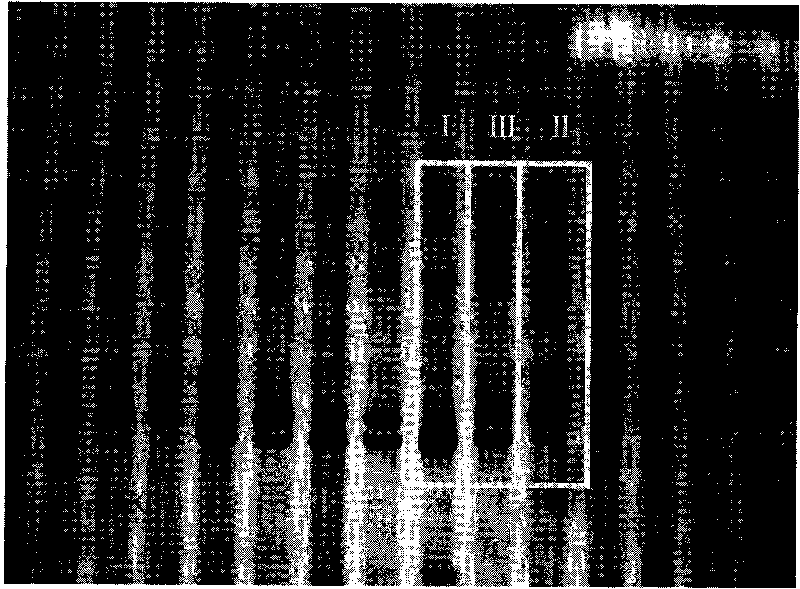Method for distinguishing conventional cotton and hybrid cotton in assistant mode and special kit thereof
A kit and hybrid cotton technology, applied in biochemical equipment and methods, microbial determination/inspection, etc., can solve the problems of inconspicuous, difficult to distinguish, and difficult to distinguish the F2 generation of hybrid materials.
- Summary
- Abstract
- Description
- Claims
- Application Information
AI Technical Summary
Problems solved by technology
Method used
Image
Examples
Embodiment 1
[0114] Embodiment 1, the composition of kit and the composition of SSR atlas
[0115] 1. The kit for assisting in identifying conventional cotton and hybrid cotton or assisting in identifying F1 generation cotton seeds and F2 generation cotton seeds consists of the following 16 pairs of primers:
[0116] Table 1, 16 pairs of primer sequences
[0117] serial number
Primer name
forward primer sequence
reverse primer sequence
1
DPL0431
CTATCACCCTTCTCTAGTTGCGTT (sequence 1)
ATCGGGCTCACAAACATCA (sequence 2)
2
NAU1042
CATGCAAATCCATGCTAGAG
GGTTTCTTTGGTGGTGAAAC
3
NAU1071
ACCAACAATGGTGACCTCTT
CCCTCCATAACCAAAAGTTG
4
NAU1085
AGTCGCCCCTTCTCTAATTT
TGTAAACCGAACTCGTTGTG
5
NAU1102
ATCTCTCTGTCTCCCCCCTTC
GCATATCTGGCGGGTATAAT
6
NAU1103
GGAGCCAGAAGTTGAGAAAA
TTCGGCTTCTGCTTTTACTT
[0118] serial number
Primer name
forward primer seq...
Embodiment 2
[0174] Embodiment 2, distinguish conventional cotton and hybrid cotton with kit and SSR collection of illustrative plates in embodiment 1
[0175] 1. The identification method is as follows:
[0176] 1) Take a cotton variety to be identified, randomly take 10 seeds for indoor germination, and obtain 10 cottons to be identified;
[0177] 2) Genomic DNA of 10 cotton cotyledons to be identified were extracted respectively;
[0178] 3) using the genomic DNA of each cotton plant as a template, carrying out PCR amplification with 16 pairs of primers respectively, and obtaining PCR amplification products corresponding to 16 pairs of primers for each cotton plant;
[0179] 4) carry out polyacrylamide gel electrophoresis to the PCR amplification products (ie all PCR amplification products) corresponding to 16 pairs of primers of each cotton plant;
[0180] 5) detect the collection of illustrative plates of the PCR amplification product of each pair of primers corresponding to each co...
Embodiment 3
[0196] Embodiment 3, use kit and SSR collection of illustrative plates to identify F1 generation cotton seeds and F2 generation cotton seeds in embodiment 1
[0197] 1) 24 seeds are randomly selected from the cotton seeds to be identified as the detection seeds;
[0198] 2) 24 test seeds were germinated indoors to obtain 24 cotton plants, and the genomic DNA of the cotyledons of the 24 cotton plants were extracted respectively;
[0199] 3) with the partial primers in Example 1, the genomic DNA of each strain of cotton is carried out to PCR amplification, obtains the PCR amplification product of each detection seed;
[0200] 4) Carry out polyacrylamide gel electrophoresis to the PCR amplification product of each detection seed, to detect the collection of pictures of the PCR amplification product of each detection seed;
[0201]If each described primer pair is corresponding to the collection of PCR amplification products of each detection seed as follows: it is consistent with...
PUM
 Login to View More
Login to View More Abstract
Description
Claims
Application Information
 Login to View More
Login to View More - R&D
- Intellectual Property
- Life Sciences
- Materials
- Tech Scout
- Unparalleled Data Quality
- Higher Quality Content
- 60% Fewer Hallucinations
Browse by: Latest US Patents, China's latest patents, Technical Efficacy Thesaurus, Application Domain, Technology Topic, Popular Technical Reports.
© 2025 PatSnap. All rights reserved.Legal|Privacy policy|Modern Slavery Act Transparency Statement|Sitemap|About US| Contact US: help@patsnap.com



